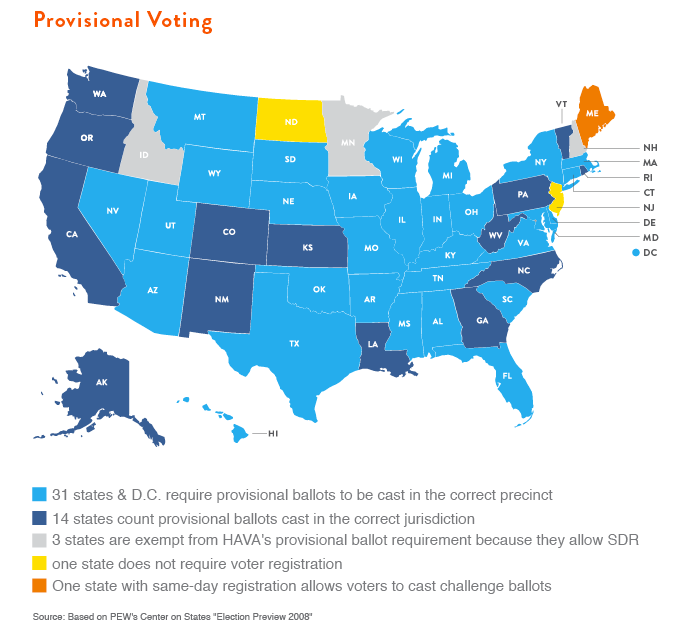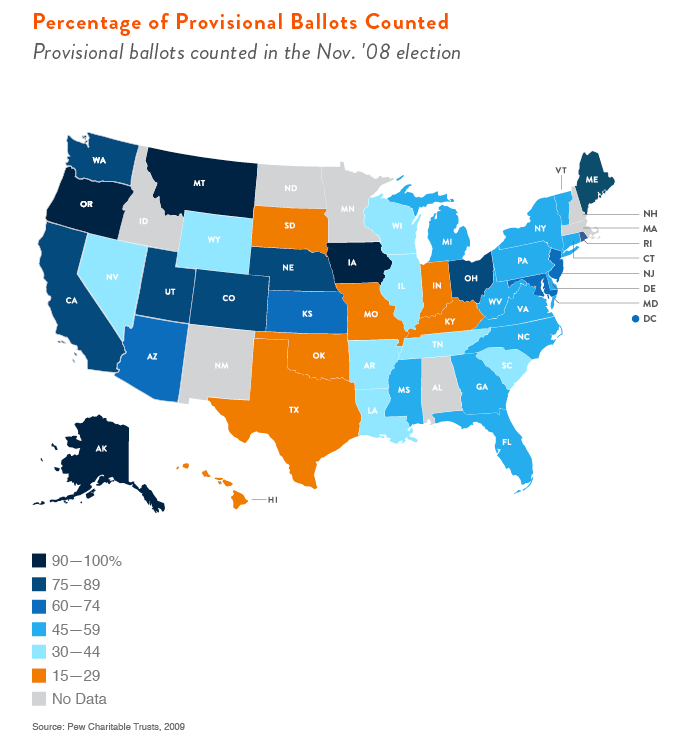- Provisional ballots are not counted as regular ballots and should be used in only very limited situations.
- Provisional ballots cast solely because an eligible voter voted in the wrong precinct or polling place should be counted as a regular ballot for any office for which the voter was eligible to vote.
- Adopting Same Day Registration would substantially decrease the need for provisional ballots because eligible voters can simply re-register if there are registration issues.
The scenario occurs regularly on Election Day: a voter will show up at the polling place only to find that his or her name is not on the voting rolls. Sometimes an incomplete registration form is to blame. Other times, people have moved since registering and may show up at the wrong polling place. But in many cases, processing errors by election administrators, overly aggressive purging procedures, or other mistakes outside of the voter’s control result in the voter being mistakenly left off the voting rolls.
Back to full report
Under the Help America Vote Act of 2002 (HAVA), voters whose names cannot be found on the voter rolls on Election Day or whose eligibility is challenged must be provided a provisional ballot.1 These provisional votes are subsequently counted if local election officials are able to verify, by a set deadline, that the individual is a legitimate voter under state law.2 The Presidential Commission on Election Administration found that “high rates of provisional balloting can . . . lead to longer lines, as voters and poll workers attempt to address confusion regarding a voter’s registration status and to provide the appropriate ballot. . . . States that require large number of voters to cast provisional ballots slow down the voting process.”3
States’ policies on provisional ballots vary. For 31 states and Washington D.C, provisional ballots must be cast in the correct precinct in order to be counted.4 Fourteen states allow for a broader application and will count the provisional ballot as long as it is cast in the correct jurisdiction.5 Four states, Idaho, Minnesota, New Hampshire, Wisconsin, and Wyoming are exempt from HAVA provisional ballot requirements because they had same day registration when HAVA was implemented, which allows eligible voters to re-register on the day they vote if there are any registration issues.6 North Dakota is also exempt because it does not require voter registration, at all. Maine also has same day registration but still allows voters to cast challenge ballots.7

In the 2008 election, four states accounted for two-thirds of all provisional ballots submitted nationally—Arizona, California8, New York and Ohio.9 These states, in particular, would benefit from reforms such as same day registration, to decrease the number of provisional ballots cast.
Even though there is wide use of provisional ballots, there are no consistent standards for when they are counted.10 In ten states, more than 75 percent of provisional ballots were counted in the 2008 elections; but in 17 states, less than 45 percent of provisional ballots were counted.11
Overuse of provisional ballots can prevent otherwise eligible votes from being counted. A survey of 43 states after the 2008 presidential election found that more than 600,000 provisional ballots were rejected for either being cast in the wrong precinct or the wrong jurisdiction even though the voters were properly registered voters.12 In addition, in the same election, more than 27,000 rejected ballots were disallowed because of various errors, including incomplete provisional ballot envelopes, missing or non-matching signatures on the provisional ballot applications, incomplete applications, and envelopes that contained no provisional ballots.13 These errors were in some cases committed by voters but many were a result of administrative problems at the polls.14
The map below shows the breakdown of the percentage of provisional ballots that were counted by state in the 2008 election.

While provisional ballots are intended to be a safeguard, the high rate of disqualified provisional ballots in many states suggests that the use of provisional ballots should be as limited as possible, and states should instead implement procedures that will allow as many voters as possible to cast a regular ballot at the polls. Ideally, measures such as Same Day Registration should be implemented to allow eligible voters to simply re-register at the time of voting, and cast a regular ballot that will be counted, if an eligible voter encounters any questions about the voter’s registration at the polling place.
Policy Recommendations
- States should adopt Same Day Registration to decrease the need for provisional ballots. In states that provide Same Day Registration, voters who discover a mistake in their registration when they appear at the polling place can simply re-register and then vote a regular ballot, greatly reducing the need for provisional ballots.
- If a voter is required to cast a provisional ballot solely because he or she voted in the wrong precinct or polling place, the votes cast on the provisional ballot should be counted as a regular ballot for any office for which the voter was eligible to vote (e.g., presidential, statewide, or countywide offices).
- If a provisional ballot is cast, the voter should be permitted to cast the ballot and written registration affirmation at the current polling place rather than having to go to a central elections office.
Back to full report
Endnotes
- 42 U.S.C. § 15482(a). ↩
- Ibid. ↩
- Presidential Commission on Election Administration, The American Voting Experience: Report and Recommendations of the Presidential Commission on Election Administration 17 (Jan. 2014) available at http://www.supportthevoter.gov/. ↩
- The Pew Center on the States, Provisional Ballots: An Imperfect Solution, (July 2009), available at http://www.pewstates.org/uploadedFiles/PCS_Assets/2009/ELEC_ProvBallot_Brief_0709.pdf. ↩
- Ibid. ↩
- Ibid. ↩
- Ibid. ↩
- California has since enacted same day registration and when implemented the number of provisional ballots cast is expected to decrease. ↩
- Ibid. ↩
- Ibid. ↩
- Ibid. ↩
- Ibid. ↩
- Ibid. ↩
- United States Election Administration Commission (EAC), 2008 Election Administration Survey, (Nov. 2009), available at http://www.eac.gov/assets/1/Documents/2008%20Election%20Administration%20and%20Voting%20Survey%20EAVS%20Report.pdf. ↩
Back to full report